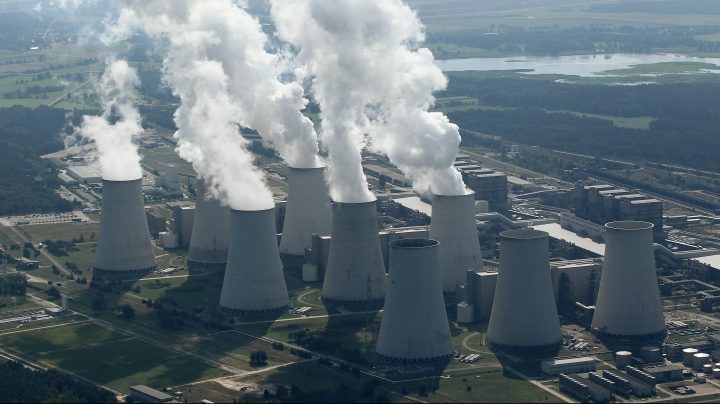
New carbon capture methods offer hopeful outlook for addressing climate change
New carbon capture methods offer hopeful outlook for addressing climate change

To reduce the world’s carbon footprint, it’s going to take more than just switching to electric vehicles or turning the lights off to conserve energy. It also has to mean removing carbon directly out of the air.
Among existing methods, planting trees might be the most well-known, but there are drawbacks. For instance, in the event of a forest fire, the carbon the trees have stored is released back into the air. Plus, some worry that there’s simply not enough space to plant the number of trees needed to make a real dent in climate change.
Companies and labs are experimenting with other methods, though. One startup, Heirloom Carbon Technologies, is working on a method that pulls carbon out of the air using the same process in nature that creates limestone. The carbon can then be stored permanently, or even used in other materials like concrete.
Adele Peters is a senior writer for Fast Company who recently profiled Heirloom. She discussed the future of the carbon capture industry with Marketplace’s Amy Scott. An edited transcript of their conversation is below.
Amy Scott: OK, let’s start with the science. As simply as you can, tell me how direct air capture works.
Adele Peters: The company I was looking at in the story, Heirloom, is basically speeding up a process that happens naturally. So they are using a powder that’s made from crushed limestone, which is a rock that forms using CO2. In nature, that takes millions of years, but they’re doing essentially the same thing in about three days. They’re mixing the powder with water and putting it outside on what looks sort of like baking trays that are stacked up in these tall racks. And as it sits there, the powder acts like a sponge for CO2, pulling it really quickly out of the air. And when they’ve collected the CO2, it can actually be stored permanently somewhere else.
Scott: That’s just crazy. I mean, first of all, how you figure out how to do something in three days that normally takes millions of years just boggles the mind. But at this point, how much carbon dioxide are they able to capture with this method?
Peters: This is still happening on a really small scale. So really, to begin to have a meaningful impact on climate change, it’s going to have to be happening at a massively larger scale. And that’s kind of what they’re aiming for. By 2035, they want to be able to pull a billion tons of CO2 out of the air every year, which is basically the same as the emissions every year from the airline industry. So it’s a huge amount.
Scott: So that’s a little over a decade from now. How realistic is that?
Peters: I mean, it still remains to be seen. But I think the process that they’re using actually is fairly straightforward. And one of the big challenges that they have now is just being able to afford to scale up. And how they do that is to sell carbon offsets, basically, to companies that want to offset their own emissions. And they need enough demand for that for them to really be able to grow to the level that this needs.
Scott: And how much does this technology cost? I mean, what kind of price are we talking to do this at the kind of scale that’s needed?
Peters: It is fairly expensive now. What they’re aiming for by 2035 is to be able to capture CO2 at about $100 per ton. That is much less than what some of these other technologies are doing right now.
Scott: It’s tempting to get excited about this — especially when you read that global carbon dioxide emissions continued to go up when we should be moving in the exact opposite direction. And I was wondering, do you think there’s a risk of betting too much on carbon removal and therefore not doing enough to reduce emissions in the first place?
Peters: Yeah, I think there’s definitely a risk that companies say, “OK, we don’t need to reduce emissions as quickly as we could because we can turn to offsets or carbon removal instead.” And this definitely doesn’t replace the need to cut emissions. But to meet climate goals, if you look at the models, countries are going to have to make huge emissions cuts and remove carbon from the air. They have to do both things, basically. So one study said by the middle of the century, we might have to remove as much as 10 billion tons of CO2 every year. And that’s on top of everything else that needs to change, like moving to electric vehicles and renewable energy and eliminating emissions as well.
Scott: You cover climate change, among other topics. How much hope is this technology giving you? Or do you think it’s still too far away to really expect this to solve this massive crisis?
Peters: I think it’s still early, but I am actually optimistic both about this and our ability to cut emissions. Most of the technology that we need already exists and it just sort of needs to be implemented. So I think there is a lot of reason for hope.
There’s a lot happening in the world. Through it all, Marketplace is here for you.
You rely on Marketplace to break down the world’s events and tell you how it affects you in a fact-based, approachable way. We rely on your financial support to keep making that possible.
Your donation today powers the independent journalism that you rely on. For just $5/month, you can help sustain Marketplace so we can keep reporting on the things that matter to you.












